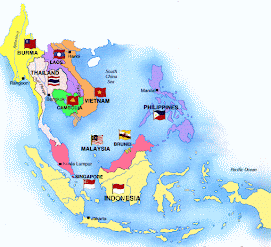On Saturday, 1st November, we went to the Peranakan Museum for the USEA(Understanding South-East Asia)seminar. The seminar was mainly divided into 3 parts, the exhibition with booths from the various schools, the exhibitions at the lecture rooms by the people at the Peranakan Museum, and a guided tour about the Peranakan culture
EXHIBITION BY VARIOUS SCHOOLS(RI, VS and ACSI)
I didn't really get to see the booths by the other schools as I was doing my shift at the booth, but I did get to have a little glimpse. I also remembered that there was a boy who came up to me, and asked me whether I wanted to try Malay perfume. It smelt quite nice, and he even mentioned that it had no alcohol in it, as Muslims are not allowed to touch alcohol
EXHIBITION AT LECTURE ROOM
There were many exhibitions going on, like the cooking exhibition and beading exhibition. The cooking exhibition was very interesting. The chef was demonstrating how to cook Nonya Curry, which smelt really good! There was even a bookmark on the recipe to make the curry powder(:
This is the recipe to cook the curry powder:
Basic Ingredients:(Makes 6 tablespoons)
1. 8 dried chillies
2. 2 table spoon Coriander seeds(ketumbar)
3. 2 tablespoon Cumin seeds(jintan puteh)
4. 1 teaspoon Whole cloves(bunga Chingkay)
5. 6" Cinnamon stick(kayu manis)
6. 1 tablespoon tumeric powder(kunyit)
7. 1 tablespoon ginger powder(halia)
8. 1 tablespoon cardamon powder(buah pelaga)
9. 1/4 teaspoon Fenugreek powder(alba)
Method:
1. Place the chillies, coriander seeds, cumin seeds, cloves and broken Cinnamon stick in a frying pan or wok
2. Dry fry the spices at low heat., stirring occasionally for about 5 minutes till lightly toasted and fragrant. Allow it to cool.
3. Transfer to a spice mill/blender and grind finely. Then transfer it to a mixing bowl and add the other spice powder. Mix it well and store it in and airtight container and keep in a cool dark place. READY TO USE!(:

The beading was very interesting too:D Beading is actually essential for all Peranakan Girls to learn, as it shows that they are well-bred.

Beaded Handkerchief

Beaded spectacle case
GUIDED TOUR
The tour was mainly to let us know about the way of life of a Peranakan. Peranakans are also called Strait Chinese. Most Peranakans are of Hokkien ancestry.
PERANAKAN WEDDING:
Stage 1: The "proposal"
The man does not go down on his knees to propose to his bride, his mum does it for him! However, his mum does not propose to the bride, she "proposes" to the bride's mother, by offering sireh to the bride's mum. If the bride's mum accepts the sireh, it means that the bride's mum has no objections to the marriage. However. if she rejects the sireh, the man's mum does not need to feel embarrassed at all!:D
 Sireh
SirehStage 2: Preparations
Instead of using money as a dowry, the groom will give his bride these few things:

Leg of a pig(signifies that he can support the family)

Jewellery(signifies that he is rich)

Oranges and alcohol

Unused cloth(signifies that he can support the family)
In turn, the bride will give the groom these few things:

Clothes that were sewn using the unused cloth and beaded slippers(signifies that she has the capability to run the household well)

Oranges and alcohol

Thigh of a pig

Jewellery
Stage 3: wedding day!
The bride will dress in very fabulously designed clothes, the nicer the better. When she goes to the parents-in-law's house, she is accompanied by a woman known as the Mistress of Ceremony. This woman is in charge of making sure that the wedding runs smoothly(:

Mistress of Ceremony(in blue)
The wedding actually runs over a couple of days, and the bride and groom have to go through many procedures and even tests(like testing the virginity of the bride).
RELIGION
Peranakans were actually very open-minded when it came to religion, therefore some Peranakans are Taoist, Christians and even Catholics.
REFLECTIONS
The Seminar really opened my eyes to the Peranakan culture. I used to think that the Peranakan culture was boring, but that was because I did not bother to learn more about it. From their cuisine to wedding procedures, it is obvious that the Peranakans are very traditional people. This seminar has also allowed me to know more about South-East Asia from the various booths(although I only managed to get a glimpse of it). The seminar has made me realise that my knowledge of SEA is very limited, and I still have a long long way to go before I can confidently say that I am an expert at SEA. The seminar has also shaped my mindset, that there is more than meets the eye-I used to think that the Perankan culture was boring, but it isn't!
I really look forward to more seminars like this:D

No comments:
Post a Comment